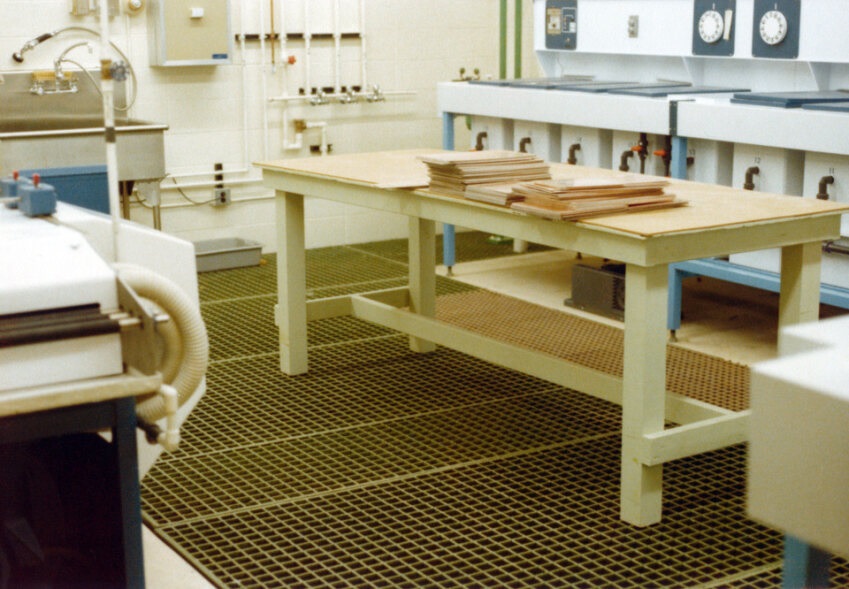In the realm of industrial operations, only the most durable materials can get the job done over...
How to Use Industrial FRP Products to Engineer Durable Work Environments
In the realm of industrial operations, only the most durable materials can get the job done over the long term. High-quality fiberglass reinforced plastic (FRP) has been used for over fifty years in some of the world’s most challenging environments. From grating solutions to structural components, our
industrial-grade FRP products such as pultruded grating are a favorite for this sector.
Composition: What Is Fiberglass Reinforced Plastic?
Every FRP product manufacturer has different formulations of fiberglass reinforced plastic. Fibergrate’s proprietary composites are made of fiberglass fibers embedded as a matrix in specialized polymer blends. Depending on the additives and surface applications used, these FRP products can be formulated for specific industrial applications with characteristics like advanced load-bearing capacity, skid resistance, or UV resistance. The FRP production process must be monitored for quality control to ensure the final product meets specifications.

Fibergrate FRP in an Industrial Manufacturing Environment
Applications of FRP Industrial Products
Here are some of the industries that use FRP from Fibergrate:
- Metals & Mining: FRP products are durable for use in mining, smelting, plating, and other common operations. Floor grating, stairways, platforms, ladders, and other structural elements can withstand the rigors of heavy machinery, abrasive materials, and corrosive chemicals.
- Oil & Gas: Offshore platforms and refineries are common use cases for FRP products in the oil and gas industry. Resistant to corrosion and able to endure the harsh marine environment with constant UV and saltwater exposure, helps maintain productive and safe operations.
- Chemical Processing: Corrosive substances pose significant challenges and metals like steel simply can not withstand the assault of chemicals without rusting, corroding, or leaching. Tanks, piping, and containment systems crafted from FRP offer unparalleled resistance to a wide range of chemicals, supporting the safe handling and storage of hazardous materials. Explore this case study from a sewage treatment facility that opted for FRP due to its high corrosion resistance.
Key Properties and Advantages of High-Quality FRP
The inherent properties of FRP set it apart from traditional materials like steel, concrete, or wood. Lightweight yet sturdy, FRP boasts a high strength-to-weight ratio. This means it can be used to build strong and durable industrial structures that can handle an impact, bear the weight of heavy machinery, or withstand traffic from trucks and other large vehicles.
FRP also exhibits excellent corrosion resistance, rendering it impervious to the corrosive effects of chemicals, moisture, and extreme temperatures. In addition, FRP’s non-conductive nature makes it a safer alternative in environments where electrical hazards are a concern.
Assessing Work Environment Needs and Challenges
What does industrial FRP need to accomplish in your specific project? Whether you are designing a new location or retrofitting existing facilities, here are some considerations.
- Identification of Durability Challenges: Areas to explore include exposure to temperature fluctuations, humidity, moisture, salt water, UV radiation, corrosive chemicals, conducted heat, heavy loads, and hard impacts.
- Safety Considerations: Hazards to explore include equipment failure, structural integrity, slip and fall hazards, chemical exposure and cleanup, electrical hazards, and fire hazards.
- Environmental Factors: The effect of building materials on the surrounding environment may include an exploration of open grating vs. solid decking in marine environments and the use of FRP vs. metal to reduce the risk of leaching substances into waterways.
By conducting a comprehensive assessment of work environment needs and challenges, stakeholders can make informed decisions regarding the selection and implementation of FRP products for industrial settings.
In situations where standard off-the-shelf products will not work, FRP can be customized to specific project requirements. Fibergrate’s engineering team can help industrial organizations create and manufacture products that meet specs for size, color, configuration, or other needs.
Maintenance and Longevity
Having strategies in place for repair and replacement as needed ensures minimal disruption to operations and prolongs the lifespan of FRP installations. By implementing comprehensive maintenance protocols, stakeholders can maximize the durability and longevity of FRP products and safeguard their investment. Fortunately, FRP is designed to be long-lasting with minimal maintenance. For most FRP products, routine cleaning is all that is required to keep it in good condition.
Quality and Durability in FRP Manufacturing
The hallmark of FRP manufacturing lies in its commitment to quality and longevity. With over 50 years of expertise, Fibergrate's certified products exemplify this dedication, setting industry standards for excellence and reliability. Fibergrate's FRP products undergo rigorous testing and adhere to stringent quality control measures to ensure optimal performance and durability in diverse industrial settings.
Conclusion
As the FRP manufacturing industry continues to evolve with more advanced composite materials, we anticipate seeing it used in even more innovative ways to uplevel industrial infrastructure. Browse through Fibergrate’s FRP markets overview and see how you can elevate your industrial environment with unparalleled durability and reliability.
Topics: FRP


